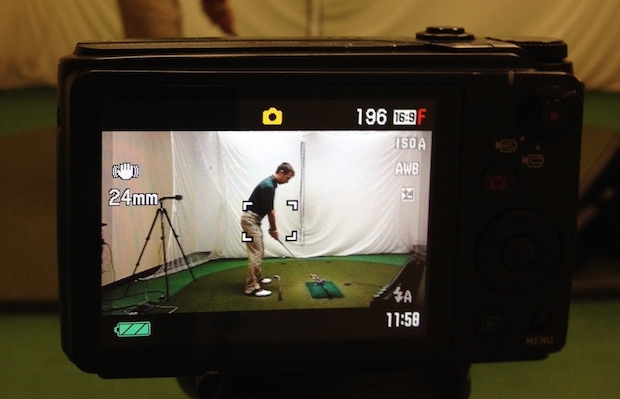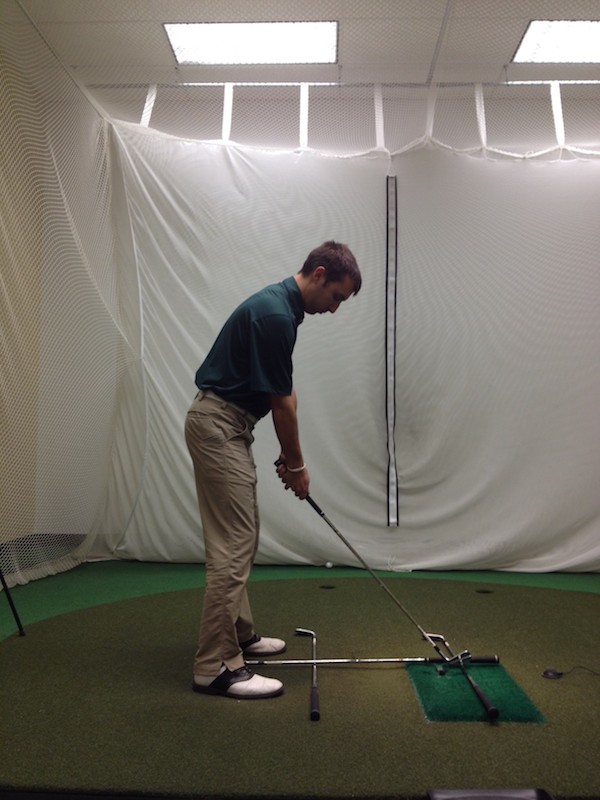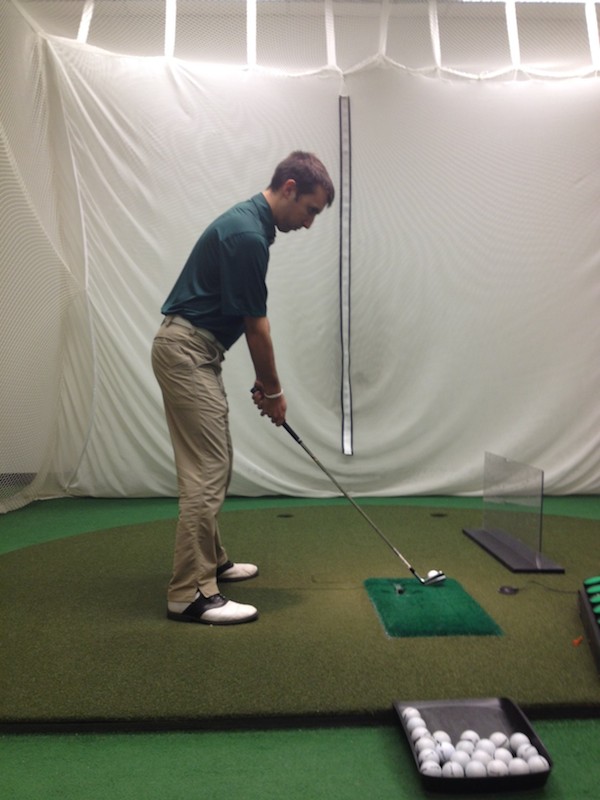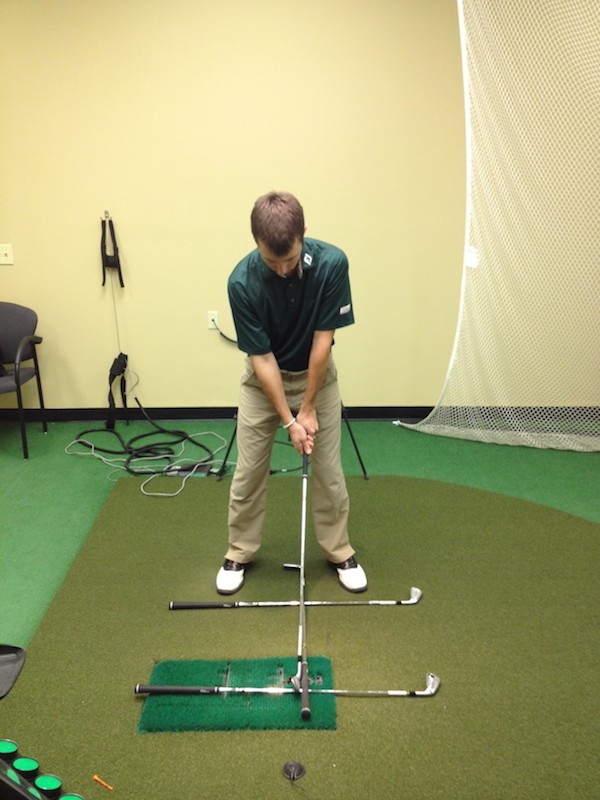Instruction
Use proper camera alignment when filming your swing

Have you ever taken a camera to the golf course or practice range, recorded your swing, and thought “Hmm, I thought I was better than that?” On the other hand, have you been afraid to take your camera to your nearest golf facility because you did not know how to set it up correctly?
Camera position is extremely important, and it is often neglected by average golfers and some golf professionals. The point of this article is to teach golfers how to properly set up a camera to video their swing from different positions. The position of the camera can change the appearance of your golf swing in many respects, and it is equally important to set up the camera properly as it is to recognize when it is done improperly.
The first step is getting the right camera. I use two cameras in my swing instruction. I work for GolfTEC, and we use a camera equivalent to a Sony GigE, which is a very expensive high-resolution, high-speed camera used for slow-motion analysis. In addition, I own two other cameras for my instruction business that I started before I took the job teaching for GolfTEC-Philadelphia, the Michael Wheeler Learning Center, LLC.
I own both a Casio EX-FH100 high-speed camera and a Sony GigE camera. I use the Casio on the golf course, while I use the Sony GigE in coordination with my JC Video software, which was set up by Mark Connell, the owner of JC Video. I also own a tripod that I can adjust the leg length and height depending on the situation to ensure a level camera position. Now, I don’t expect golfers to go purchase a $1,000 camera to videotape their swings, as most digital cameras are good now for these purposes. I recommend a camera with at least 30 frames per second recording capability, and something with at least 640 x 480 recording pixels so you can see your video clearly. Now to the second step, which is to understanding how to properly set up the camera.
There are two primary camera positions when you will videotape your golf swing: down-the-line and face-on.
Down-the-line essentially means that the camera is pointing down the target line. There are three positions that Golf Magazine Top-100 instructors and other great instructors use when setting up a down-the-line swing video. The first is on the hands, keeping the HANDS between the camera and the target (photo 1). The second is set up on the target line, keeping the BALL between the camera and the target (photo 2). The third, final, and probably least used, camera position is set up on a golfer’s foot line, keeping the FEET between the camera and the target (photo 3).
Photo 1
Photo 2
Photo 3
My mentor in the business is Ted Sheftic, a Golf Magazine Top-100 instructor, and Pennsylvania’s No. 1 teacher as ranked by Golf Digest. I have been working with Ted for more than 15 years, and he taught me using the camera position set up on the hands. So, for purposes of this article (and any of my future articles), we will talk about setting up the camera in that position. Follow these steps to set up a down-the-line swing video in the proper position:
- Place the camera on a tripod and set the height to EXACTLY hand height and level.
- Set up a ball from where the golfer will be hitting and set up to that ball.
- Place a club on the ground PARALLEL to the target line directly underneath your hands.
- This should be approximately 3-to-4 inches in front of the feet at address, between a golfer’s toes and the ball.
- Line up the camera directly in line with the hand line (the shaft used to represent the hand line should be perfectly straight in the camera’s viewfinder — see photo)
- Hit record!
After a while, golfers will be able to set up down-the-line swing videos very quickly and efficiently, and golfers can quicken the process with the help of a friend or family member. If you decide to use the other camera positions, remember that those will change the LOOK of your swing when you review the swing, which will be discussed in the next article.
Lastly, let’s discuss how to set up a face-on swing video. If you have only one camera, make sure you mark the position of the down the line tripod position before moving to avoid having to repeat the steps mentioned above again. You can use duct tape, tees, etc., to do this. Most of the steps for a face-on video will be the same as the down-the-line, but they are modified to be appropriate for the different position.
- Assure the camera is still at hand height and level.
- Set up a ball from where the golfer will be hitting.
- Place a club on the ground PERPENDICULAR to the target line (form a “T” with the target line club and the ball position club) in line with the golf ball. This will represent the ball position between a golfer’s feet and in relation to his or her body.
- Line up the camera so that the golfer is directly in the middle of the camera’s viewfinder.
- Hit record!
Follow these steps and set up the camera in the same place every time to ensure consistency and help track swing process. In the next article, I will explain golfers you will be able to see from each position, and also what golfers would see if you set up the camera in the wrong position.
Remember, it is best to consult a PGA professional before making swing changes. You wouldn’t prescribe yourself medicine without seeing a doctor, so don’t try to fix your golf swing without professional advice. Best of luck and keep practicing!
Instruction
The Wedge Guy: Beating the yips into submission

There may be no more painful affliction in golf than the “yips” – those uncontrollable and maddening little nervous twitches that prevent you from making a decent stroke on short putts. If you’ve never had them, consider yourself very fortunate (or possibly just very young). But I can assure you that when your most treacherous and feared golf shot is not the 195 yard approach over water with a quartering headwind…not the extra tight fairway with water left and sand right…not the soft bunker shot to a downhill pin with water on the other side…No, when your most feared shot is the remaining 2- 4-foot putt after hitting a great approach, recovery or lag putt, it makes the game almost painful.
And I’ve been fighting the yips (again) for a while now. It’s a recurring nightmare that has haunted me most of my adult life. I even had the yips when I was in my 20s, but I’ve beat them into submission off and on most of my adult life. But just recently, that nasty virus came to life once again. My lag putting has been very good, but when I get over one of those “you should make this” length putts, the entire nervous system seems to go haywire. I make great practice strokes, and then the most pitiful short-stroke or jab at the ball you can imagine. Sheesh.
But I’m a traditionalist, and do not look toward the long putter, belly putter, cross-hand, claw or other variation as the solution. My approach is to beat those damn yips into submission some other way. Here’s what I’m doing that is working pretty well, and I offer it to all of you who might have a similar affliction on the greens.
When you are over a short putt, forget the practice strokes…you want your natural eye-hand coordination to be unhindered by mechanics. Address your putt and take a good look at the hole, and back to the putter to ensure good alignment. Lighten your right hand grip on the putter and make sure that only the fingertips are in contact with the grip, to prevent you from getting to tight.
Then, take a long, long look at the hole to fill your entire mind and senses with the target. When you bring your head/eyes back to the ball, try to make a smooth, immediate move right into your backstroke — not even a second pause — and then let your hands and putter track right back together right back to where you were looking — the HOLE! Seeing the putter make contact with the ball, preferably even the forward edge of the ball – the side near the hole.
For me, this is working, but I am asking all of you to chime in with your own “home remedies” for the most aggravating and senseless of all golf maladies. It never hurts to have more to fall back on!
Instruction
Looking for a good golf instructor? Use this checklist

Over the last couple of decades, golf has become much more science-based. We measure swing speed, smash factor, angle of attack, strokes gained, and many other metrics that can really help golfers improve. But I often wonder if the advancement of golf’s “hard” sciences comes at the expense of the “soft” sciences.
Take, for example, golf instruction. Good golf instruction requires understanding swing mechanics and ball flight. But let’s take that as a given for PGA instructors. The other factors that make an instructor effective can be evaluated by social science, rather than launch monitors.
If you are a recreational golfer looking for a golf instructor, here are my top three points to consider.
1. Cultural mindset
What is “cultural mindset? To social scientists, it means whether a culture of genius or a culture of learning exists. In a golf instruction context, that may mean whether the teacher communicates a message that golf ability is something innate (you either have it or you don’t), or whether golf ability is something that can be learned. You want the latter!
It may sound obvious to suggest that you find a golf instructor who thinks you can improve, but my research suggests that it isn’t a given. In a large sample study of golf instructors, I found that when it came to recreational golfers, there was a wide range of belief systems. Some instructors strongly believed recreational golfers could improve through lessons. while others strongly believed they could not. And those beliefs manifested in the instructor’s feedback given to a student and the culture created for players.
2. Coping and self-modeling can beat role-modeling
Swing analysis technology is often preloaded with swings of PGA and LPGA Tour players. The swings of elite players are intended to be used for comparative purposes with golfers taking lessons. What social science tells us is that for novice and non-expert golfers, comparing swings to tour professionals can have the opposite effect of that intended. If you fit into the novice or non-expert category of golfer, you will learn more and be more motivated to change if you see yourself making a ‘better’ swing (self-modeling) or seeing your swing compared to a similar other (a coping model). Stay away from instructors who want to compare your swing with that of a tour player.
3. Learning theory basics
It is not a sexy selling point, but learning is a process, and that process is incremental – particularly for recreational adult players. Social science helps us understand this element of golf instruction. A good instructor will take learning slowly. He or she will give you just about enough information that challenges you, but is still manageable. The artful instructor will take time to decide what that one or two learning points are before jumping in to make full-scale swing changes. If the instructor moves too fast, you will probably leave the lesson with an arm’s length of swing thoughts and not really know which to focus on.
As an instructor, I develop a priority list of changes I want to make in a player’s technique. We then patiently and gradually work through that list. Beware of instructors who give you more than you can chew.
So if you are in the market for golf instruction, I encourage you to look beyond the X’s and O’s to find the right match!
Instruction
What Lottie Woad’s stunning debut win teaches every golfer

Most pros take months, even years, to win their first tournament. Lottie Woad needed exactly four days.
The 21-year-old from Surrey shot 21-under 267 at Dundonald Links to win the ISPS Handa Women’s Scottish Open by three shots — in her very first event as a professional. She’s only the third player in LPGA history to accomplish this feat, joining Rose Zhang (2023) and Beverly Hanson (1951).
But here’s what caught my attention as a coach: Woad didn’t win through miraculous putting or bombing 300-yard drives. She won through relentless precision and unshakeable composure. After watching her performance unfold, I’m convinced every golfer — from weekend warriors to scratch players — can steal pages from her playbook.
Precision Beats Power (And It’s Not Even Close)
Forget the driving contests. Woad proved that finding greens matters more than finding distance.
What Woad did:
• Hit it straight, hit it solid, give yourself chances
• Aimed for the fat parts of greens instead of chasing pins
• Let her putting do the talking after hitting safe targets
• As she said, “Everyone was chasing me today, and managed to maintain the lead and played really nicely down the stretch and hit a lot of good shots”
Why most golfers mess this up:
• They see a pin tucked behind a bunker and grab one more club to “go right at it”
• Distance becomes more important than accuracy
• They try to be heroic instead of smart
ACTION ITEM: For your next 10 rounds, aim for the center of every green regardless of pin position. Track your greens in regulation and watch your scores drop before your swing changes.
The Putter That Stayed Cool Under Fire
Woad started the final round two shots clear and immediately applied pressure with birdies at the 2nd and 3rd holes. When South Korea’s Hyo Joo Kim mounted a charge and reached 20-under with a birdie at the 14th, Woad didn’t panic.
How she responded to pressure:
• Fired back with consecutive birdies at the 13th and 14th
• Watched Kim stumble with back-to-back bogeys
• Capped it with her fifth birdie of the day at the par-5 18th
• Stayed patient when others pressed, pressed when others cracked
What amateurs do wrong:
• Get conservative when they should be aggressive
• Try to force magic when steady play would win
• Panic when someone else makes a move
ACTION ITEM: Practice your 3-6 foot putts for 15 minutes after every range session. Woad’s putting wasn’t spectacular—it was reliable. Make the putts you should make.
Course Management 101: Play Your Game, Not the Course’s Game
Woad admitted she couldn’t see many scoreboards during the final round, but it didn’t matter. She stuck to her game plan regardless of what others were doing.
Her mental approach:
• Focused on her process, not the competition
• Drew on past pressure situations (Augusta National Women’s Amateur win)
• As she said, “That was the biggest tournament I played in at the time and was kind of my big win. So definitely felt the pressure of it more there, and I felt like all those experiences helped me with this”
Her physical execution:
• 270-yard drives (nothing flashy)
• Methodical iron play
• Steady putting
• Everything effective, nothing spectacular
ACTION ITEM: Create a yardage book for your home course. Know your distances to every pin, every hazard, every landing area. Stick to your plan no matter what your playing partners are doing.
Mental Toughness Isn’t Born, It’s Built
The most impressive part of Woad’s win? She genuinely didn’t expect it: “I definitely wasn’t expecting to win my first event as a pro, but I knew I was playing well, and I was hoping to contend.”
Her winning mindset:
• Didn’t put winning pressure on herself
• Focused on playing well and contending
• Made winning a byproduct of a good process
• Built confidence through recent experiences:
- Won the Women’s Irish Open as an amateur
- Missed a playoff by one shot at the Evian Championship
- Each experience prepared her for the next
What this means for you:
• Stop trying to shoot career rounds every time you tee up
• Focus on executing your pre-shot routine
• Commit to every shot
• Stay present in the moment
ACTION ITEM: Before each round, set process goals instead of score goals. Example: “I will take three practice swings before every shot” or “I will pick a specific target for every shot.” Let your score be the result, not the focus.
The Real Lesson
Woad collected $300,000 for her first professional victory, but the real prize was proving that fundamentals still work at golf’s highest level. She didn’t reinvent the game — she simply executed the basics better than everyone else that week.
The fundamentals that won:
• Hit more fairways
• Find more greens
• Make the putts you should make
• Stay patient under pressure
That’s something every golfer can do, regardless of handicap. Lottie Woad just showed us it’s still the winning formula.
FINAL ACTION ITEM: Pick one of the four action items above and commit to it for the next month. Master one fundamental before moving to the next. That’s how champions are built.
PGA Professional Brendon Elliott is an award-winning coach and golf writer. You can check out his writing work and learn more about him by visiting BEAGOLFER.golf and OneMoreRollGolf.com. Also, check out “The Starter” on RG.org each Monday.
Editor’s note: Brendon shares his nearly 30 years of experience in the game with GolfWRX readers through his ongoing tip series. He looks forward to providing valuable insights and advice to help golfers improve their game. Stay tuned for more Tips!















Tom McCarthy
Feb 17, 2014 at 11:29 am
I like to have another view of the golfer’s swing, from directly behind them in order to look at the action of the hips, legs, and shoulders from this angle. Its a great feedback view on how much the hips move laterally on the backswing and downswing.
Michael Wheeler
Feb 17, 2014 at 5:55 pm
That is true… I just covered the two most popular views of face on and down the line. However, the camera position for the behind camera will be set up in the same manner of the face on camera. The behind camera is an excellent resource when working on weight shift, seeing the hips, etc, like you said.
Shawn Smith
Jan 19, 2014 at 8:45 pm
This article came out at the right time. I just got a sony action cam for christmas to go along with my V1 premium mobile app. I will be filming my swing for the first time this year. I used to get instruction from Goltec in Berwyn PA and buy my gear at the willow grove golfsmith. I’ll look you up if I ever decide to get Golftec lessons again. Great information here!
Pat C
Jan 19, 2014 at 2:07 pm
Forgot to ask a question. What about setup for recording your putting?
Michael Wheeler
Feb 17, 2014 at 5:53 pm
Pat, the same rules will apply, and it goes a little deeper in the next article, which is being published this week. With putting the only two spots I personally use for putting is the hands (set up the same way) to see the entire stroke (body and club). I will also sometimes put the camera on the target line on the ground (explained in the next article), with a close up view of the putter head and maybe about a foot of the shaft. This will show you the arc of the stroke and whether it is inside and down the line, straight back to straight through, etc.
Hope this helps.
Pat C
Jan 19, 2014 at 2:04 pm
Enjoyed the tips for setting up video camera. Will be looking for next article.
jl
Jan 17, 2014 at 8:50 pm
Sorry, quite confusing. Saying “keeping the hands between the camera and the target” literally could mean the camera being placed anywhere, as long as it was behind the golfer. If you really meant “keeping the hands on a Line between the camera and the target, that’s not what your photo shows. A line from the camera to the hands does not extend to the target. In your next example, “keeping the ball between the camera and the target”, I believe you meant “keeping the ball on a Line between the camera and the target”, this is in fact what you did. A line from the camera goes straight to the ball and then to the target.
Michael Wheeler
Jan 27, 2014 at 9:59 am
jl sorry it took so long to get back to you. When I was writing this I had to debate how to word it to make it as easy to understand as possible. The reason why it appears that the target is not on the hands in the pictures is due to the fact that the net in front of me is only about 10 feet away. If the target were to be further away it would appear as if the hands are closely in line with the target (ideally the hands should be in the center of your screen, but you need to make sure it is lined up). If you use the simple steps with the clubs it will help you set it up directly in line with the hands. The next article will be more in depth with where in height the camera should be when it is on the target line versus the hands, and what you will see if you do it incorrectly. So stay tuned!
WRG
Jan 16, 2014 at 5:38 pm
I like your last comment, but my job doesn’t offer golf insurance, also known as Sh*nk insurance.